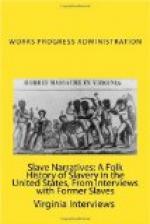“When freedom come on I was on Hawkin Lankford Simpson place. It was 3 or 5 miles from town. They had a big dinner-picnic close by. It was 4 or 5 day of August. A lot of soldiers come by there and said, ’You niggers air free.’ It bout broke up the picnic. The white folks broke off home. Them wanted to go back went, them didn’t struck off gone wild. Miss Lucy and Mr. Bob Barnett give all of em stayed some corn and a little money. Then he paid off at the end of the year. Then young master went and rented at Dilly Hunt place. We stayed wid him 3 or 4 years then we went to a place he bought. Tom Barnett come to close to Little Rock. Mars William started and died on the way in Memphis. We come on wid the family. Guess they are all dead now. Wisht I know or could find em. Tom never married. He was a soldier. One of the boys died fo the war started.
“My brother Joe married Luvenia Omsted and Lewis Omsted married my sister Betsy and Mars Tom Williams swapped the women. My ma was a cook for the white folks how I come to know so much bout it all. Boys wore loose shirts till they was nine or ten years old. The shirt come to the calf of the leg. No belt.
“We had plenty common eating. They had a big garden and plenty milk. They cooked wid the eggs mostly. They would kill a beef and have a week of hog killing. They would kill the beef the hardest weather that come. The families cooked at night and on Sunday at the log cabins. They cook at night for all next day. The old men hauled wood.
“When I was a little boy I could hear men runnin’ the slaves wid hounds in the mountains. The landmen paid paddyrollers to keep track of slaves. Keep em home day and night.
“We took turns bout going to white church. We go in washin’ at the creek and put on clean clothes. She learned me a prayer. Old mistress learned me to say it nights I slept up at the house. I still can say it:
’Now I lay me down to sleep
I pray the Lord my soul to keep
If I should die fo I wake
I pray the Lord my soul to take.’
“The slaves at our places had wheat straw beds. The white folks had fine goose feather beds. We had no idle days. Had a long time at dinner to rest and rest and water the teams. Sometimes we fed them. Old mistress had two peafowls roosted in the Colonial poplar trees. She had a pigeon house and a turkey house. I recken chicken and goose house, too. When company come you take em to see the farm, the garden, the new leather things jes’ made and to see the little ducks, calves, and colts. Folks don’t care bout seeing that now.
“The girls went to Florence to school. All I can recollect is them going off to school and I knowed it was Florence.




